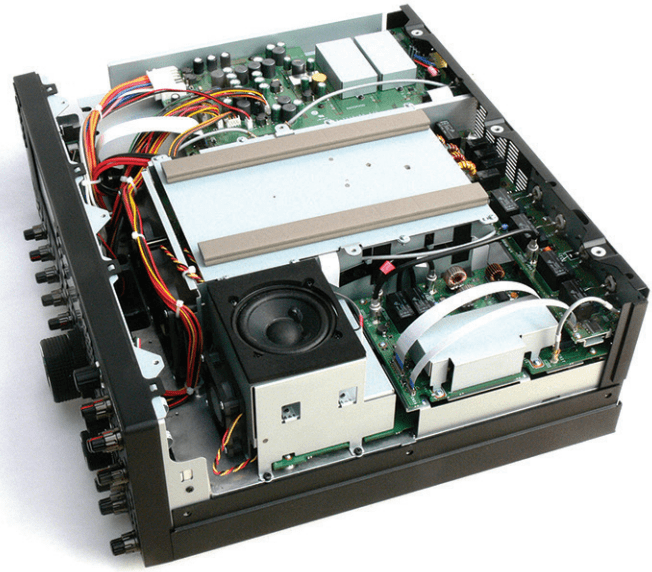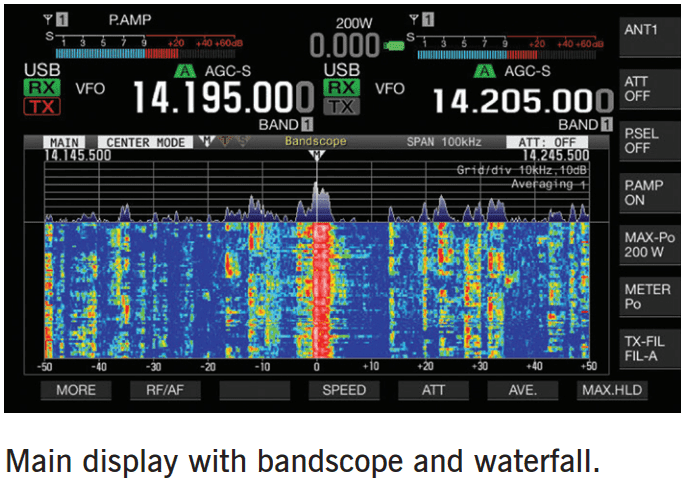RADIO DESIGN AND ARCHITECTURE. The main receiver in the TS-990S follows current
practice for high performance radios away from upconversion to a low IF and a suite of
roofng flters. The frst IF is 8.248MHz with roofng flters of 270Hz, 500Hz, 2.7kHz,
6kHz and 15kHz ftted as standard, selectedeither manually or automatically according
to mode and channel bandwidth. There is provision for a sixth user-ftted flter. The
second IF is 24kHz to feed the DSP for all subsequent processing.
The sub receiver adopts the same architecture and circuitry as the TS-590S. On
certain amateur bands (160, 80, 40, 20 and 15m) and with bandwidths less than 2.7kHz,
the receiver converts to an IF at 11.374MHz with 2.7kHz or 500Hz roofng flters and
then to 24kHz for DSP processing. Over the remainder of the tuning range or wider
bandwidths, the sub receiver upconverts first to a 73MHz IF with a 15kHz roofng flter,
then via 10.7MHz with 15kHz, 6kHz or 2.7kHz flters and fnally to 24kHz.

Separate 32 bit floating point DSPs for the main and sub receivers are used to
provide IF channel fltering, demodulation, noise reduction, audio processing and AGC
functions. On FM, separate FM ICs perform demodulation and pass audio to the DSPs.
On this mode the DSP is used purely for audio fltering functions. A third DSP is used
by the band scope. The main receiver uses a switching frst
mixer and 15 input bandpass flters to cover the total frequency range, relay-switched on
the fve key bands and diode-switched on the remainder. A tuneable preselector may also be
enabled to further reduce out of band signals.
The sub receiver uses a quad arrangement of MOSFETs in both frst mixer signal paths
together with 13 diode-switched bandpass filters. Both receivers use switchable bipolar
preamplifers in the front end with nominally 12dB gain up to 21.5MHz and 20dB gain
above and switchable attenuators for really strong signal situations. The local oscillator
feed for the main receiver uses a PLL / DDS combination at VHF and a divider to achieve
low phase noise. A 0.1ppm TCXO reference ensures high stability and accuracy and is
available as a 10MHz reference via a rear panel connector to drive other equipment.
Alternatively the radio can operate from an external reference. The transmit signal path
uses the upconversion sub receiver frequency scheme in reverse.
The radio is solidly constructed with shielded modular units around a substantial
diecast frame, well packed there is a lot to this radio. The PA has a large fnned heatsink
and a total of fve internal fans keep the radio cool. These are fairly quiet with variable
speed and only operate when the temperature rises, which is rarely under normal use. A
single 7.5cm speaker fts in the case top.

DISPLAYS. The radio uses two full-colour LCD panels that are particularly clear and
bright with good viewing angles. The larger 7-inch main display indicates frequencies,
S-meters and status messages for both main and sub receivers at all times. The main
meter can emulate an analogue style or bargraph format and the sub meter uses a
bargraph. The lower part of the display is used for a variety of purposes including a high
resolution spectrum scan, message panels for the RTTY and PSK decoders and for menu
access and setup, graphical displays used in the various setup screens and memory
channel listing. The display is touch sensitive when displaying spectrum scans and will
tune the radio to the touched area.
The smaller 3.5-inch sub display is located immediately above the main tuning
drive and enables frequencies to be displayed and read with minimum eye movement. It
also indicates the audio spectrum overlaid with full details of the channel bandwidth
setting, including notch flter placement. On data modes it provides a useful tuning
indicator, an X-Y scope on RTTY and a vector scope on PSK.
For retro addicts or those with fond memories of the tuning scales of the past,
the smaller display can emulate the dial ring of an analogue mechanical drive and, in
SWL mode, the main display can emulate the string driven ribbon scale of classic short
wave receivers such as the Trio 9R-59. Overall there is far more information
presented in such a user-friendly way than by any other radio to date.

